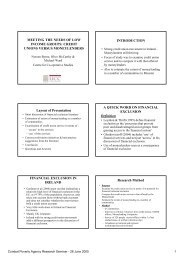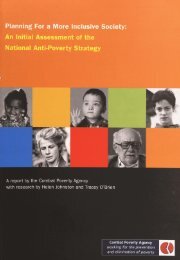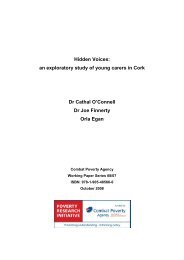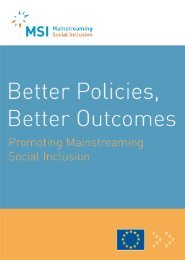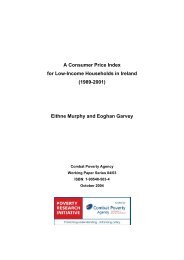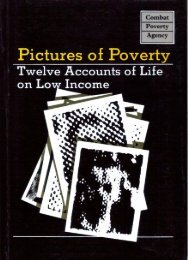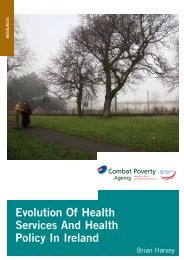The Distribution of Income in Ireland (2000) - Combat Poverty Agency
The Distribution of Income in Ireland (2000) - Combat Poverty Agency
The Distribution of Income in Ireland (2000) - Combat Poverty Agency
- No tags were found...
You also want an ePaper? Increase the reach of your titles
YUMPU automatically turns print PDFs into web optimized ePapers that Google loves.
24 <strong>The</strong> <strong>Distribution</strong> <strong>of</strong> <strong>Income</strong> <strong>in</strong> <strong>Ireland</strong>ill head or one work<strong>in</strong>g full-time <strong>in</strong> the home. In 1994, thesedifferences <strong>in</strong> mean <strong>in</strong>come across the groups accounted forabout 27 per cent <strong>of</strong> the <strong>in</strong>equality <strong>in</strong> the overall sample. By1997, the <strong>in</strong>equality produced by these differences <strong>in</strong> mean <strong>in</strong>comehad fallen, and accounted for 24 per cent <strong>of</strong> overall <strong>in</strong>equality.In terms <strong>of</strong> with<strong>in</strong>-group <strong>in</strong>equality, there was a sharp<strong>in</strong>crease for households headed by someone unemployed or ill.<strong>The</strong> size <strong>of</strong> some <strong>of</strong> the groups had also changed, with the proportion<strong>of</strong> employees <strong>in</strong>creas<strong>in</strong>g and unemployed fall<strong>in</strong>g.Table 3.7: Decomposition <strong>of</strong> Inequality <strong>in</strong> DisposableEquivalised <strong>Income</strong> by Labour Force Status <strong>of</strong> Head, 1994and 1997 LLT SurveyA: 1994GroupEmployeeSelf-employedUnemployed/illRetiredHome DutiesAllOf which:Inequalitywith<strong>in</strong> Group(MLD*1000)1012405510575160With<strong>in</strong> group <strong>in</strong>equality (% <strong>of</strong> total)Between group <strong>in</strong>equality (% <strong>of</strong> total)B: 1997EmployeeSelf-employedUnemployed/illRetiredHome DutiesAllOf which:9923510011665167With<strong>in</strong> group <strong>in</strong>equality (% <strong>of</strong> total)Between group <strong>in</strong>equality (% <strong>of</strong> total)Group Mean<strong>Income</strong>(£ per week)152.50140.3269.59112.3482.92123.64116(72.9)44(27.1)188.65187.3386.16142.9693.73159.35128 (76.4)39 (23.6)Group Share <strong>in</strong>Population(%)4119171210100461914139100F<strong>in</strong>ally, it is <strong>in</strong>terest<strong>in</strong>g to focus on the role <strong>of</strong> social welfaretransfers by dist<strong>in</strong>guish<strong>in</strong>g two groups: households which re-<strong>The</strong> <strong>Distribution</strong> <strong>of</strong> <strong>Income</strong> <strong>in</strong> the 1990s 25ceive more than half their total <strong>in</strong>come from transfers andhouseholds which do not. Table 3.8 shows that, unsurpris<strong>in</strong>gly,the 30 per cent <strong>of</strong> households who do receive more than halftheir <strong>in</strong>come from transfers have both lower mean equivalised<strong>in</strong>come and lower with<strong>in</strong>-group <strong>in</strong>equality than the rest <strong>of</strong> thesample. <strong>The</strong> table also shows that <strong>in</strong>equality between these twogroups accounted for about 35 per cent <strong>of</strong> overall <strong>in</strong>equality <strong>in</strong>the 1994 sample.Table 3.8: Decomposition <strong>of</strong> Inequality <strong>in</strong> DisposableEquivalised <strong>Income</strong> by Social Welfare Dependency, 1994and 1997LLT.SurveysGroupInequalitywith<strong>in</strong> Group(MLD*1000)A: 1994Social Welfare13650% or Less <strong>of</strong>Total <strong>Income</strong>Social Welfare29More that 50% <strong>of</strong>Total <strong>Income</strong>All160Of which:With<strong>in</strong> group <strong>in</strong>equality (% <strong>of</strong> total)Between group <strong>in</strong>equality (% <strong>of</strong> total)B: 1997Social Welfare50% or Less <strong>of</strong>Total <strong>Income</strong>Social WelfareMore that 50% <strong>of</strong>Total <strong>Income</strong>All13736167Of which :With<strong>in</strong> group <strong>in</strong>equality (% <strong>of</strong> total)Between group <strong>in</strong>equality (% <strong>of</strong> total)Group Mean<strong>Income</strong>(£ per week)147.3368.02123.64104 (65.2)56 (34.8)183.8379.75159.35113(67.9)54(32.1)Group Share <strong>in</strong>Population(%)By 1997, <strong>in</strong>equality with<strong>in</strong> both groups had <strong>in</strong>creased, and accountedfor a slightly larger share <strong>in</strong> total <strong>in</strong>equality than <strong>in</strong>1994. This reflects the fact that although the mean <strong>in</strong>come <strong>of</strong>70301007624100




